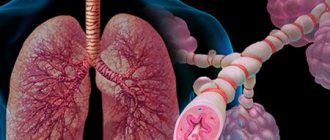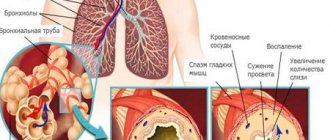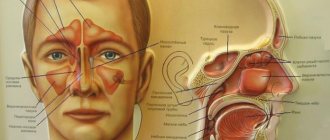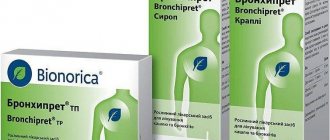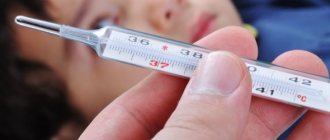What is bronchial sputum
Bronchial sputum, strictly speaking, cannot be called a disease; it is a clinical sign of inflammation of the respiratory tract and, in particular, the bronchial tree. However, in everyday language the term is often used as a synonym for the inflammatory process.
In some cases, the inflammatory process is determined by the disease, in others, on the contrary, it is a consequence of inhalation of various irritating substances, including smoking.
Despite the variety of causes that can determine inflammation of the bronchi, it is always characterized by excessive production and accumulation of thick mucus or phlegm.
How does bronchial inflammation develop?
To understand how inflammation develops, it is necessary to understand what mucus is and what its functions are .
Mucus is a colloidal mixture of viscous consistency and has a dual task:
- Maintain constant moisture of the mucous membranes, preventing them from drying out.
- Filtration of air that passes through the respiratory tract. Particles and microorganisms that manage to pass through the nasal cavities become stuck in mucus.
Under physiological conditions , the amount of mucus produced by the glands is small (does not exceed 200 milliliters) , but this is enough to cover the entire surface of the mucous membranes with a thin film, providing protection and hydration of the entire respiratory tree.
Disposal of accumulated mucus and adherent particles is ensured by a protective mechanism known as "mucociliary clearance" . The mucous membranes are covered with millions of invisible cilia, which produce coordinated movements and, at the same time, push mucus to the glottis, where it is swallowed into the stomach.
However, if the respiratory tract is covered by an inflammatory process , then the movements of the cilia slow down, and the amount of mucus secreted increases, which becomes denser due to saturation with blood cells such as leukocytes. All this causes stagnation and accumulation of mucus , which under such conditions takes on the character of bronchial sputum .
At this moment, an additional safety mechanism is triggered - cough .
Coughing is a protective reflex and occurs through strong exhalation with a closed glottis and its subsequent sharp opening. Increasing the pressure in the respiratory tract and, as a result, the speed at which air escapes, allows you to remove excess mucus and foreign bodies.
General rules of treatment
You can cleanse your lungs as quickly as possible by using medications of different effects.
As for various procedures and traditional methods of treatment, they are used as additional means that do not eliminate the cause, but improve the general condition.
Treatment must be very thorough, since stagnant mucus can lead to various complications.
The standard treatment regimen for accumulated sputum looks like this:
- It is necessary to visit a doctor for examination and examination.
- Based on the results obtained, the cause and type of pathology is established.
- Drinking a large amount of liquid that will dilute the mucus, especially if the water contains a decoction of medicinal herbs or another medicinal product.
- It is important to ensure that there is an optimal level of humidity in the room.
- Be sure to take various medications and folk remedies orally. These are drugs that have a thinning effect and provide an optimal antibacterial and anti-inflammatory effect.
- It is advisable to perform special exercises daily to eliminate phlegm.
To remove phlegm from the lungs as quickly as possible, dilute it in every possible way . In such a diluted state, sputum will be cleared from the lungs much faster and easier. The doctor will select the optimal remedy for this purpose.
To speed up the process and improve the results obtained, treatment with medications must be supplemented with folk remedies.
There are many methods for cleansing the lungs. Among them we can note various syrups, decoctions, tinctures, mixtures, as well as inhalations and physical exercises, which are no less effective in solving the problem of how to remove phlegm from the bronchi using folk remedies.
The use of traditional medicine prescribed by a doctor is a safer method of treatment that can be used by a pregnant woman.
https://youtu.be/https://www.youtube.com/watch?v=Wl-3V_Qirxw
_
Causes of bronchial inflammation
The reasons that can cause inflammation of the lower respiratory tract, which leads to the formation of bronchial sputum, as already mentioned, are varied, but the most basic and most common can be identified.
Pathological. The main diseases that can lead to the appearance of bronchial sputum are:
- Bronchitis. Inflammation of the bronchi caused by a viral or bacterial infection.
- Chronic obstructive pulmonary disease. Which restricts the passage of air as a result of chronic inflammation. The cause is usually cigarette smoking.
- Tuberculosis. Infection of the lungs and lower respiratory tract with the mycobacterium Mycobacterium tuberculosis.
- Whooping cough. Infection with the bacterium Bordetella pertussis.
- Asthma.
- Neoplasms of the lower respiratory tract.
Non-pathological. of irritants over a long period of time . Among the most common is, of course, cigarette smoke. Other irritants may be dust and fumes present in the workplace, such as dust, textile lint, grain dust, etc.
Expectorant herbs
To liquefy mucus and remove it from the respiratory system, it is worth considering various means that are taken orally during the treatment process.
These can be different herbal compositions and specially prepared mixtures from certain medicinal products . Here are some of the most effective herbal treatment recipes.
Collection No. 1
Herbs that have a very good expectorant effect are marshmallow, thermopsis, St. John's wort, ivy, and coltsfoot..
These herbs can be used individually or all together.
To prepare the medicinal composition, you need to take a couple of spoons of the mixture, pour 500 ml of boiling water and, after infusing for an hour, take half a glass three to four times a day.
Collection No. 2
An equally high positive effect can be obtained by using a mixture based on licorice, violet and coltsfoot . These herbs are taken in equal proportions and mixed thoroughly.
To prepare the medicinal composition, you need to take a spoonful of the mixture and a glass of boiling water, let it brew for half an hour. After this, the decoction is filtered and drunk in several doses over the course of one week.
Collection No. 3
Another effective treatment method is based on mixing sage, pine buds, licorice root.
All this is taken in equal quantities and brewed with boiling water. The optimal proportion is one tablespoon per two glasses of water.
The decoction must be infused for three hours and taken strictly two spoons, strained, every three hours.
This is a universal mixture that can be used both internally and as inhalation.
Monastic fee
A special monastic collection known to many is very popular in the process of removing sputum. It contains herbs such as:
- sage;
- nettle;
- series;
- immortelle;
- bearberry;
- buckthorn;
- birch buds;
- chamomile;
- linden flowers.
All of these components are very useful and effective in themselves, and also significantly enhance the overall effect of each other.
The method of preparing a medicinal infusion is quite simple. A tablespoon of a mixture of herbs is poured into a glass of boiling water, brewed and taken one third of a glass three times a day.
The total treatment time is from one to three months . This technique helps very well in complex treatment, that is, simultaneously with medications.
Pine cones
Pine cones are good at thinning mucus and have an ideal anti-inflammatory effect..
To prepare a medicinal infusion, you need to take 10 small buds and dry them very well. After this, the cones are poured with 500 ml of water and boiled for about 30 minutes.
After this, the broth should be left for an hour, add honey and take one-fourth of a glass.
The total treatment time is 10 days; if necessary, after a short break the process can be repeated.
Elderberry treatment
Pour 200 ml of boiling water over two tablespoons of dried berries and leave for 5 minutes . Everything is thoroughly boiled for 2 minutes over medium heat and, after cooling, poured into a bottle.
Everything is tightly closed and left for one day to brew in a dark place. It is advisable to take this drink warm and at least two cups per day.
This must be done until the main symptoms of the disease are completely eliminated.
To improve the overall taste, add a small amount of sugar.
Symptoms accompanying bronchial sputum
All symptoms that accompany the formation of bronchial sputum depend on the nature of the inflammatory process.
Cough. More or less plentiful.
Sputum, which can be of different colors and textures, indicating the nature of the inflammation:
- Liquid, pearlescent, almost transparent sputum. A sign of inflammation without pathogens and therefore caused by asthma or irritation of the bronchial tree, for example from smoking cigarettes.
- Thick, sticky, yellow to green sputum. This is a sign of a bacterial infection. The color is caused by traces of pus expelled along with sputum.
- Thick, sticky, dark green and offensive sputum. A sign of inflammation caused by gangrene followed by bacterial infection.
- Sputum streaked with blood. Appears when the mucous membranes are ulcerated and bleeding occurs, therefore, it is associated with dangerous diseases such as cancer or tuberculosis.
- Serous sputum, slightly thick, foamy and whitish in color. May be a sign of bronchiole/alveoli cancer.
- Serous sputum, slightly thick, foamy and pink in color. May be a sign of pulmonary edema (accumulation of fluid in the lung tissue in the space of additional vessels).
Difficulty breathing is associated with clogging of the airways with mucus.
Pain in the chest or back in the area between the shoulder blades.
The appearance of fever with temperature, which, in the case of bacterial infections, can reach high values.
Medicinal mixtures and products
There are several options for treating the respiratory system and removing phlegm, which are based on the use of various useful products. Among the most effective are the following:
- Black radish . This is a product unique in its taste and level of usefulness. A fairly large hole is made in the inside of the fruit and is completely filled with honey. The resulting composition is taken in a small spoon 4-5 times a day. This is an ideal remedy for treating children, as it is very healthy and tasty at the same time.
- A decoction of milk and oats . In the process of removing excess mucus from the lungs and bronchi, a decoction of oatmeal with the addition of a small amount of milk helps well. A glass of cereal is poured with 500 ml of milk and boiled until the total amount of the mixture is equal to one glass. The resulting gruel is consumed before meals three times a day.
- Great results in treatment can be achieved if you use a mixture of nuts and herbs . To prepare the medicinal composition, you will need to take lemons, aloe juice, bearberry and walnuts in equal parts. You need to add 200 grams of honey to the resulting mixture. As a treatment, you need to take a spoonful 2 times a day. This form of treatment should continue for one week.
- Young onions are an ideal expectorant . The head of this vegetable must be mixed with honey, taking these components in equal quantities. In this case, you need to chop the onion using a blender, using it to obtain juice. The composition is taken 1-2 spoons, at least twice a day for one week.
Speaking about medicinal products, it can be noted that honey helps very well in the treatment process.
It can be used with a wide variety of ingredients and taken in any form. The product can be mixed with squeezed aloe juice, mixing it in a ratio of 1:5. You can consume honey with melted lard, taking one teaspoon three times a day.
Diagnosis of the causes of bronchial sputum
Primary diagnosis is carried out on the basis of observation of the clinical picture and, therefore, the symptoms that accompany the formation of bronchial sputum.
Additional clinical and laboratory tests may be required to confirm the diagnosis:
- Chest X-ray to rule out pneumonia.
- Spirometry. A test that measures breathing capacity to rule out asthma.
- Sputum culture to determine the possible causative agent of infection.
Treatment with breathing exercises
There is a special set of breathing exercises that is designed to solve the problem associated with removing mucus from the respiratory system. Here are the most effective and simple exercises:
- exhale and inhale evenly and alternately, alternating with fractional exhalations;
- the abdominal muscles retract, air is drawn in and exhaled sharply with protrusion of the abdomen;
- the stomach remains motionless, at the same time the air is inhaled deeply, the collarbones lower and rise;
- An exercise similar to blowing soap bubbles is performed.
This short set of breathing exercises should be done for up to seven days, three times a day.
